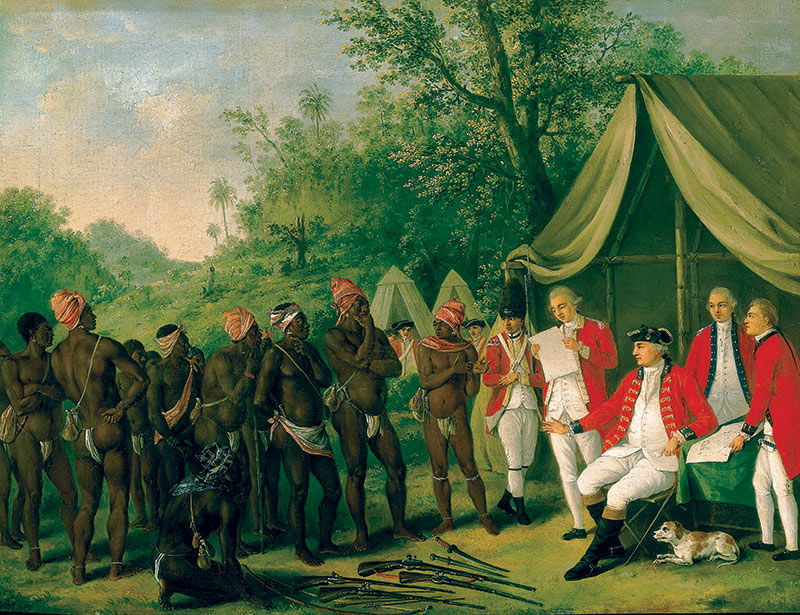The Long Fight for Liberty
Maroon freedom fighters on two Caribbean islands helped hasten the abolition of slavery.

Of the millions of enslaved Africans in the Americas, only those in Hispaniola and Guiana mounted rebellions that brought freedom. Elsewhere, uprisings were brutally suppressed. These books chronicle two rare exceptions. Runaway Maroons in British Jamaica and Dominica gained dominion over substantial hinterlands on their islands. Both established viable communities in mountainous terrain adverse to British troops, were abetted by kindred plantation slaves and menaced the plantation system, aiding slavery’s ultimate demise.
Jean Besson relates how Africans who fled Spanish servitude won autonomy after Britain captured Jamaica in 1655. As slave-worked lowland sugar plantations expanded, so did marronage in the mountainous interior, where newly arrived African slaves and locally born Creoles joined previous escapees. Maroons fighting colonial militias (1725-38) secured self-rule and land rights, but a second war (1795-96) saw many Maroons deported, their lands confiscated.
Plantation rebels of mixed race – ‘slave master pickny’ in patois parlance – fought ‘for their mothers against their fathers’. Professing loyalty to the Crown (as opposed to Jamaica’s plantocracy) and promising to repel runaway slaves, the remaining Maroons gained self-governing freedom. Using rich oral and written sources, Besson shows how Maroon culture and institutions, initially tribal African, became creolised. Jamaican nationalists honour Maroon freedom fighters as heroic forebears. Coupling marronage with slave resistance that established free villages certifies almost all Jamaicans as Maroons. Besson’s brilliant, subtle and empathetic book illuminates this hard-won heritage.
Lennox Honychurch’s vivid account features the freedom saga of smaller but equally rugged Dominica, a persisting indigenous Amerindian homeland. African runaways joined and then displaced native Kalinagos (Caribs), who turned against them. British-French rivalries and alliances with isolated coastal settlements furthered Maroon dominion of Dominica’s interior. So ungovernable was the island that Franco-British treaties of the 1660s left it a neutral Amerindian sanctuary, whose abundant timber the seafaring Kalinagos canoed to French sugar islands in exchange for tools and rum.
Desultory European enterprise scarcely impinged on Maroon highland control until British conquest in 1761 inaugurated large-scale plantation slavery. It came too late to flourish. Alongside the white French peasant proprietors, free blacks and mulattos had developed a small-scale mixed-crop economy: ‘Britain found it near impossible to smother the previously established community with its own.’
Hundreds of free mulattos from the French islands of Martinique and Guadeloupe, along with former slaves fleeing Napoleonic re-enslavement, settled in Dominica. After Britain sanctioned Catholic electoral and office-holding rights, mixed-race Dominican landowners outnumbered whites and gained control of the local Assembly in 1836 – the first colonial legislature dominated by men of African descent. Dominica’s ‘Mulatto Ascendancy’ held sway for two generations. Its legacy, along with Maroon autonomy, became a vital local collective memory.
Honychurch stresses Dominica’s extraordinary impact on British imperial slavery. Led by a Martiniquan incomer’s evocation of Thomas Paine’s The Rights of Man, in 1791 plantation slaves demanded more time to work for themselves. The planters’ refusal incited an island-wide strike. Brouhaha over Domincan slaves’ ‘arrogance’ enabled the planters’ London lobby to delay Britain’s slave trade abolition until 1807. Concurrently, African slaves shipped to Dominica to combat the Maroons rebelled against an abusive local governor. The ensuing fracas killed over a hundred Africans; a subsequent inquiry faulted the governor. Consequently Britain’s 1807 Mutiny Act banned slaves from military service and freed 10,000 black soldiers, the first mass imperial emancipation. Honychurch’s entrancing island narrative illumines wider issues of race and power, rule and resistance, slavery and freedom.
- Transformations of Freedom in the Land of the Maroons: Creolization in the Cockpits Jamaica
Jean Besson
Ian Randle Publishers, 390pp, $49.95
- In the Forests of Freedom: The Fighting Maroons of Dominica
Lennox Honychurch
Papillote Press, 120pp, £9.99
David Lowenthal is author of The Past is a Foreign County – Revisited (Cambridge, 2015).